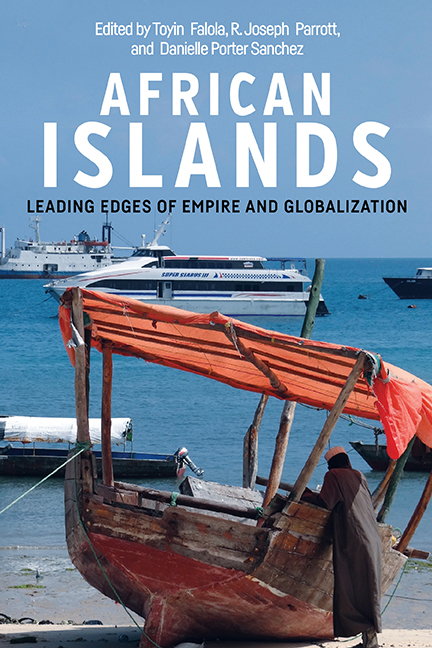Book contents
- Frontmatter
- Dedication
- Contents
- Introduction: Arbiters and Witnesses of Change: Contextualizing Conversations on African Islands
- Part 1 Atlantic Ocean Islands
- Part 2 Indian Ocean Islands
- 8 Africa's Indian Ocean Islands, Near and Distant
- 9 Monsoon Metropolis: Migration, Mobility, and Mediation in the Western Indian Ocean
- 10 The Mascarenes, Indian Ocean Africa, and Global Labor Migration during the Eighteenth and Nineteenth Centuries
- 11 The Island as Nexus: Zanzibar in the Nineteenth Century
- 12 Slavery and Postslavery in Madagascar: An Overview
- 13 The Comoros: Strategies of Islandness in the Indian Ocean
- 14 Gendered Pioneers from Mayotte: An Ethnographic Perspective on Travel and Transformation in the Western Indian Ocean
- Notes on Contributors
- Index
9 - Monsoon Metropolis: Migration, Mobility, and Mediation in the Western Indian Ocean
from Part 2 - Indian Ocean Islands
Published online by Cambridge University Press: 31 August 2019
- Frontmatter
- Dedication
- Contents
- Introduction: Arbiters and Witnesses of Change: Contextualizing Conversations on African Islands
- Part 1 Atlantic Ocean Islands
- Part 2 Indian Ocean Islands
- 8 Africa's Indian Ocean Islands, Near and Distant
- 9 Monsoon Metropolis: Migration, Mobility, and Mediation in the Western Indian Ocean
- 10 The Mascarenes, Indian Ocean Africa, and Global Labor Migration during the Eighteenth and Nineteenth Centuries
- 11 The Island as Nexus: Zanzibar in the Nineteenth Century
- 12 Slavery and Postslavery in Madagascar: An Overview
- 13 The Comoros: Strategies of Islandness in the Indian Ocean
- 14 Gendered Pioneers from Mayotte: An Ethnographic Perspective on Travel and Transformation in the Western Indian Ocean
- Notes on Contributors
- Index
Summary
The documentary As Old as My Tongue (2009) opens with a shot of a jahazi (dhow) floating at sea, its sails billowing in the Indian Ocean breeze, and then cuts to the image of an early modern map, tracking the long ocean journey following the monsoon winds from India and Arabia all along the African coast down to Zanzibar. Against this visual backdrop, the voice one hears is that of Bi Kidude, the irrepressible diva of Zanzibari taarab and unyago music, who then appears on screen, shown with her band at sea on the deck of the dhow, preparing to launch into a performance. Bi Kidude is wearing her trademark kerchief, her face lined with experience, wise and wry and fierce—an altogether formidable presence. Often described as a legend, certainly Kidude's early life was shrouded in mystery. Her birthdate unknown, she was a poor rural coconut harvester's daughter who grew up rough, sang and traveled mostly in obscurity, and rose to fame only in the last decades of her life. She defied conventions of gender and social norms, smoking, drinking, and living as she pleased, driven by the power of that uncompromising voice.
In the documentary, she describes the origins of her music, sometime perhaps in the 1920s as a youth, when she began to hang out at the port during monsoon season, drawn by the transoceanic traffic there, where no “good girl” was ever supposed to go. “I was a hooligan, a beach hooligan” (mhuni wa pwani), she laughed, dressing like a sailor in ragged clothes and barefoot, transgressing Zanzibari notions of respectable or moral behavior in multiple ways. In the city, she said, the news would spread that the Arab jahazis had arrived, the ones with wealth, beautifully appointed, with rugs and everything inside, just like a “ship” (meli). And when these dhow crews from ports all over the Indian Ocean would land in Zanzibar, they would gather along the shore to entertain themselves, and there Bi Kidude first heard the pulsating rhythms of their madumbak drums.
- Type
- Chapter
- Information
- African IslandsLeading Edges of Empire and Globalization, pp. 267 - 293Publisher: Boydell & BrewerPrint publication year: 2019

